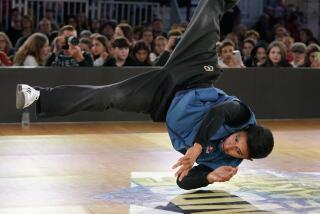Taking the Plunge : Tired of routine? How about bungee jumping--flinging yourself from a hot-air balloon and bouncing at the end of a rubber cord.
- Share via
It’s against the law in the United States to tie a long rubber cord to your waist and throw yourself from a bridge.
From a hot-air balloon, now that’s legal.
Bungee jumping--named for the bungee cord, a virtually unbreakable rubber rope developed by the military to attach tanks to parachutes--is an outlaw sport that’s found a safe haven in the skies above Lancaster. Almost every weekend, dozens of jumpers dive off a tethered hot-air balloon without fear of being busted by either the ground or the law.
“It’s totally legitimate,” says a spokesman for the Federal Aviation Administration. “As long as the balloon is tethered, there’s nothing in federal regulations that prohibits it.”
Finding a legal alternative to bridges and railroad trestles has made bungee jumping a mainstream recreation activity in a league with parachuting, sky diving and hang-gliding.
Bungee-jumping businesses are springing up, but there’s only one in the Los Angeles area. Since opening last July, Studio City-based Cowabungee has dangled about 1,000 people on its cord.
“If you’re looking for a big adrenaline rush, this is it,” says Dave Barlia, a 26-year-old Arizona State grad who is one of Cowabungee’s three owners.
Barlia, a licensed pilot and balloonist, started the business because he and his bungee-jumping friends were tired of being scofflaws. They would drive into the Angeles National Forest, find a deserted bridge or overpass and plunge into the void. But there was always a risk of being caught.
Barlia and his partners could have erected a crane like the one in Palo Alto. But a crane works the opposite way a balloon does: As the crane rises and stretches the cord, the jumper is held on the ground by several accomplices and then released. The effect is something like being fired from a slingshot. And cranes are big, bulky and difficult to move, unlike balloons.
“You can jump more people with a crane, and you’re not governed by the weather, but cranes are just not that appealing,” Barlia says.
Barlia wanted to base the balloon in Moorpark but couldn’t find a big enough parcel of public land or a private owner willing to let Cowabungee use his property. The San Fernando Valley was not a viable choice.
“If the balloon broke free from its tether, you wouldn’t want to be flying around L.A.,” Barlia says.
Accidents in bungee jumping are rare, Barlia says: “I’ve only heard of a few deaths. There were two in New Zealand off a bridge--the cords were too long--and two on cranes in France. I’ve never heard of anybody in the U.S. getting killed.”
Barlia says Cowabungee has had no injuries except for the common “bungee kiss,” a stinging bruise that happens to about one out of 10 jumpers when they get slapped by the cord.
But Cowabungee can’t get liability insurance, which means that jumpers have to sign a waiver.
“This is a lot safer than people think,” Barlia says. But it’s not for the weak-hearted, children under four feet tall or pregnant women (weight requirements: nobody under 100 pounds or over 220).
“There’s not one person who hasn’t been scared,” Barlia says. “We had one girl who’s knees were shaking so bad the balloon shook, but we’ve only had two people chicken out completely.”
Rich Riedel of Hollywood has taken the plunge four times. “It’s the closest you can come to zero gravity,” he says. “Flying back up in the air really flips me out.”
Riedel, an assistant film editor, recently bought his girlfriend her first bungee jump. “She didn’t want to do it,” he says, “but after she jumped, she was on cloud nine and didn’t stop thanking me.”
Barlia says the male-female ratio is about 3 to 1, but he’s noticed some peculiar behavioral differences between the sexes. “On the ground, the guys are macho, but in the balloon, they’re scared,” he says. “The girls are completely honest: They’re scared all the time.”
Cowabungee operates only on weekends. The cost for one jump is $99, which includes 15 minutes of instruction and a videotape of your jump. On typical first jumps, Barlia tethers the balloon at 150 feet; an on-board altimeter measures the height.
The jumper, secured in a harness attached to a 50-foot-long, 3/4-inch-thick cord (along with a couple of auxiliary safety cords), either dives or falls backward off a platform after supporters on the ground count down from five.
“The countdown is like peer pressure,” Barlia says. “But a lot of people need three or four countdowns before they jump.”
The jumper literally reaches the end of the rope when the cord is completely stretched out at 100 feet. There is no sudden stop, but the recoil jerks the jumper back up about 75 feet. He or she bounces like a Yo-Yo for a few moments before Barlia lowers the balloon and the jumper lands gently on his or her feet.
“Jumping is a weird feeling,” Barlia says.
To double the weird feeling, Barlia will raise the balloon to 300 feet and let jumpers use a 100-foot cord that stretches twice its length. The charge is $99.
Prospective jumpers should be aware of a major sacrifice they will have to make, especially if they like sleeping in on the weekend: Barlia gets to Lancaster before sunrise and has the balloon airborne by first light. The last jumpers go off about 10:30 a.m., when the winds begin kicking up. Their stomachs return to earth a little later.
More to Read
Sign up for The Wild
We’ll help you find the best places to hike, bike and run, as well as the perfect silent spots for meditation and yoga.
You may occasionally receive promotional content from the Los Angeles Times.






